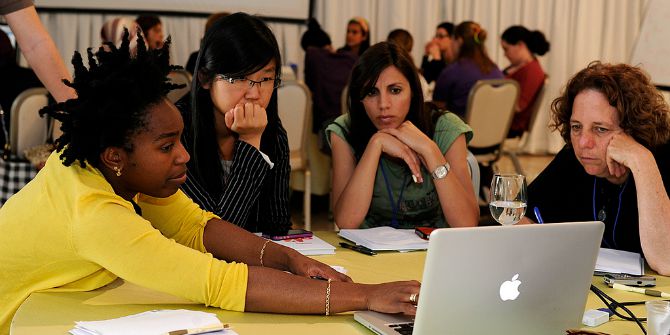Investment in diversity, equity and inclusion is critical to business performance and ability to compete, but the lack of meaningful change remains a barrier to progress. An often-overlooked pathway to change is to work inclusively across teams. Teresa Almeida and Grace Lordan write that by hyper-focusing on their teams, leaders can end up working in silos, and the benefits of inclusion efforts do not cascade across the organisation.
Faced with economic uncertainty and competition for talent, companies have decreased investment in diversity, equity and inclusion (DEI) programmes. We are at a critical juncture, with many leaders questioning if their expectations for continued progress will be met. According to a recent DEI forecast, organisations are at risk of losing major talent, with more than 40 per cent of senior leaders from minority ethnic and racial backgrounds planning to quit to advance their careers.
Although the past few years have solidified the growing consensus that DEI is critical to organisations’ business performance and ability to compete, the lack of meaningful change remains a significant barrier to progress. Much of the focus on DEI practice is on equipping leaders with insight and tools to create inclusive team environments, which are crucial for enhancing team decisions and performance. Research shows that actions to reduce groupthink, build psychological safety and cultivate feelings of belonging help foster inclusion. By experimenting with this advice, leaders can figure out what works for them and improve outcomes. However, an often-overlooked pathway to change is to work inclusively across teams and functions.
To maximise the benefits of diversity and inclusion, organisations should aim to build inclusive environments not only within but also between teams. With the structure of work changing, teams are increasingly more adaptive, dynamic, distributed and interdependent, no longer ‘lone islands of activity’. If leaders are hyper-focused on their teams, they can end up working inclusively in silos, and the benefits of such efforts do not cascade across the organisation. For those leaders who are increasingly frustrated with the pace of DEI change, breaking silos can help them connect and learn from others’ experiences. Heightened visibility role-models change for those who are lagging behind.
Effectively managing inclusion between teams is not only beneficial for leaders, but crucial for harnessing the advantages of diverse workforces. It taps into the organisation’s collective intelligence. Extensive research on group behaviour shows that fostering connections across groups can elicit alternative ways of thinking and behaving, which in turn stimulates innovation. These connections can be visualised as social networks – with ties representing the relationships between individuals and their relative position. When team members establish ties outside of their core team and work inclusively, they enhance their own group’s effectiveness by bringing in novel information, provided they can reflect and use this information. Similarly, leaders can enhance their team’s creativity by engaging in peer exchange networks, particularly when they learn from others’ successful experiments and mistakes.
To foster inclusive environments, organisations must overcome the boundaries built around teams and adopt approaches that embrace the interconnected nature of organisational structures. To do this, they can tap into a set of two strategies, which we have named the “LaW” of breaking silos. The first strategy involves building windows, ways of increasing the transparency between teams, unveiling their inner workings and progress. Imagine these windows as a lens through which managers can gain valuable insights into the ongoing efforts and opportunities across the organisation. By implementing these structural actions, even time-poor managers can gain knowledge beyond their immediate teams. The second strategy revolves around setting up ladders, actions that bring individuals together across teams, fostering active learning and knowledge exchange. Through these interconnected ladders, leaders and team members can forge meaningful connections, benefiting from one another’s insights and collectively propelling the organisation towards an inclusive collaborative work culture.
Building windows
Insights from behavioural science show the importance of increasing the visibility of role models to accelerate the change of social norms. When thinking about sharing the progress of DEI, focus not just on statistical metrics but also on the narratives surrounding that progress. This can help others better understand successful paths for inclusion. We conducted interviews with 100 diverse workers in professional and financial services organisations across various career stages, and nearly all (95 people) mentioned that their ideal work style is a version of hybrid working. This area has been extensively linked to DEI, particularly since the COVID-19 pandemic. Importantly, putting hybrid preferences into context, half of those interviewed highlighted the connection between flexible working and the ability to better manage parenting and caring responsibilities. Sharing team insights on employee experiences such as these, alongside metrics like demographics, can help teams learn from each other.
In Roberson and Perry’s thematic analysis of how leaders perceive and demonstrate inclusive leadership, respondents emphasised the team as a collective and the importance of appreciating and using the unique skills found within it. However, another important part of the inclusion puzzle is how to appreciate and support employees in the broader organisation. Inclusive leaders are best placed to identify a team member’s unique skills or aspirations. Championing them and offering them access to opportunities could mean ensuring they have access to internal training and growth opportunities to apply those skills in a different area of the business. Being more transparent around the sorts of skills that those in your team want to develop or explore can help them thrive and progress in the organisation.
Rob Pierre, CEO of Jellyfish – a global advertising agency – has realised this, and taken bold steps to adapt work and team structures so that people can learn and grow within the business. Instead of line managers, each team member has a support network tasked with different roles. One person is responsible for helping develop key skills in one’s career, ensuring that individuals can make contributions and progress according to their goals and are given opportunities for growth, while someone else supports them on personal matters. The lesson for leaders is that supporting team members could mean offering them a variety of career opportunities within the firm, fairly distributing opportunities beyond the context of the team. By building windows, these can become visible and easily accessible across the organisation.
Setting ladders
DEI advocates have long understood that for diversity and inclusion initiatives to be successful, there needs to be a shared ambition and commitment to enact change. It’s important to connect diverse employees across teams, supporting and aligning employee resource groups to employees’ expectations and the business’s DEI priorities. Yet another source of untapped potential is to assign team members as connectors, or “weak ties”, tasked with working across functions, building connections and exchanging knowledge with other teams. Using social network analysis tools to monitor this relational data can provide insight into collaboration between teams, and help diffuse positive organisational change.
A second way to connect across teams is for leaders to take deliberate actions to connect with each other. A series of interviews with 100 leaders on how they manage their relational ecosystem showed that reaching out to others in similar roles is an effective way to break out of the insular nature of the team and understand how they were able to tackle similar issues. Leaders who deliberately took the time to engage outside their team were able to more quickly leverage the expertise of others to tackle complex challenges, even co-creating new solutions. Managers could for example set-up a “leader roulette”, committing to going for a coffee with a peer every week so they learn and share experiences and complement each other’s knowledge and resources.
Conclusion
To break down the barriers and unleash the full potential of DEI, it is essential to remove silos and foster inclusive environments between teams. Organisations must build windows for transparency and encourage leaders to set ladders to connect across teams. By adopting these strategies, they can tap into the collective intelligence of diverse workforces, drive innovation, and create a culture of inclusion that attracts and retains top talent.
- This blog post represents the views of its author(s), not the position of LSE Business Review or the London School of Economics.
- Featured image provided by Shutterstock.
- When you leave a comment, you’re agreeing to our Comment Policy.





